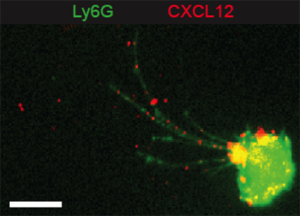
A trail of messenger molecules left behind by general immune system cells helps virus-specific T-cells reach tissues infected by influenza, reports a new study published in Science that was co-authored by Northwestern Medicine scientist Richard J. Miller, PhD.
Nonspecific white bloods cells called neutrophils are the first to respond during inflammation, the immune system’s initial effort to protect the body from infection. Later, white blood cells designed to ward off the virus called CD8+ T-cells reach those sites.
“The question is, how do these different sets of white blood cells know where to go and when during the inflammatory response? What is it about neutrophils that tells the T-cells to arrive?” said Miller, the Alfred Newton Richards Professor of Pharmacology.
Working with scientists from the University of Rochester Medical Center in New York, he helped show that neutrophils release a trail of messenger molecules called CXCL12 chemokines that leads the T-cells to infection sites.

“The chemokines tell the T-cells to follow them to the surface of the inflammation,” said Miller, who is also a professor of Medical Humanities and Bioethics in the Department of Medical Education.
Miller’s lab created transgenic mice that allowed the scientists to see the immune system’s response to influenza in vivo for the first time. Understanding the molecular mechanisms behind immune responses may help investigators manipulate them in the future to help patients.
“It’s very important to be able to dissect the process of inflammation so that we can regulate it better. Inflammation has good and bad aspects to it. We want to encourage the good and reduce the bad,” Miller said.
In ongoing research, Miller continues to study chemokine actions. Just as these molecules can guide white blood cells in the immune system during inflammation, they can also direct other cells in different parts of the body. Miller’s lab is investigating how chemokines signal stem cells to move in response to stroke-mediated brain damage.
This study was funded by National Institutes of Health grants HL087088, AI102851 and HHSN272201400005C; the WCU Neurocytomics Program at Seoul National University Graduate School in Seoul, South Korea; and American Heart Association grant 11SDG7520018.






